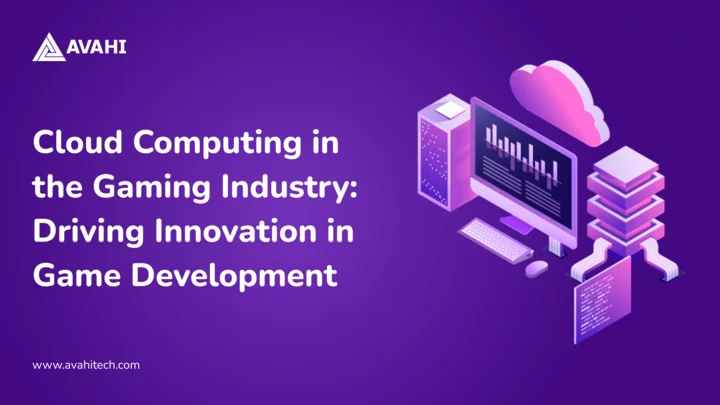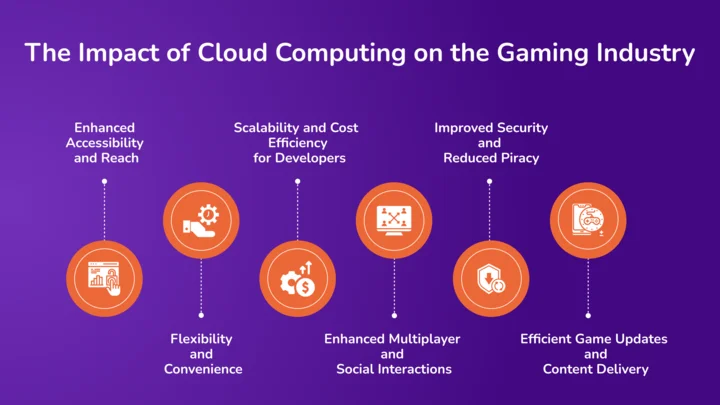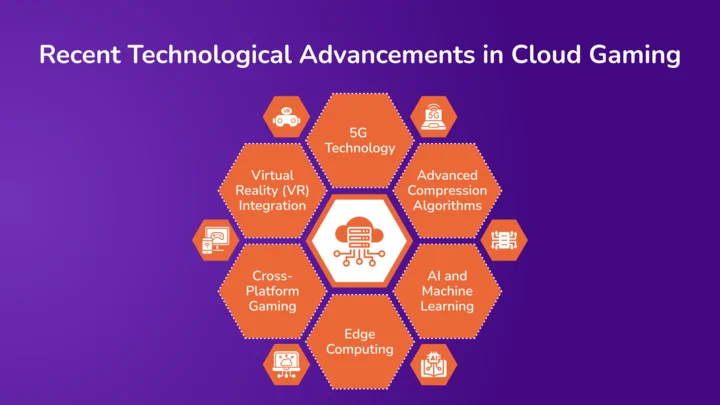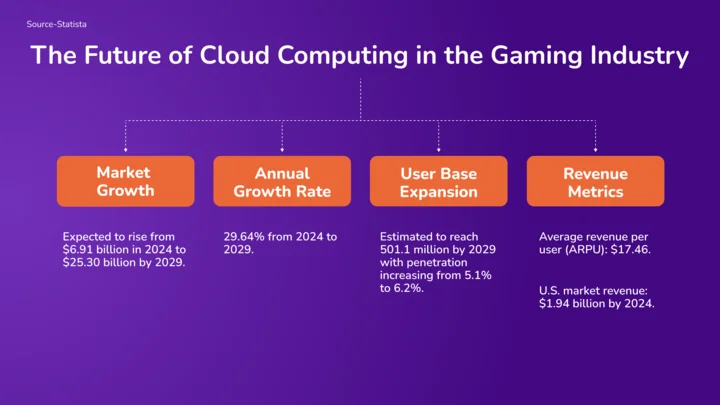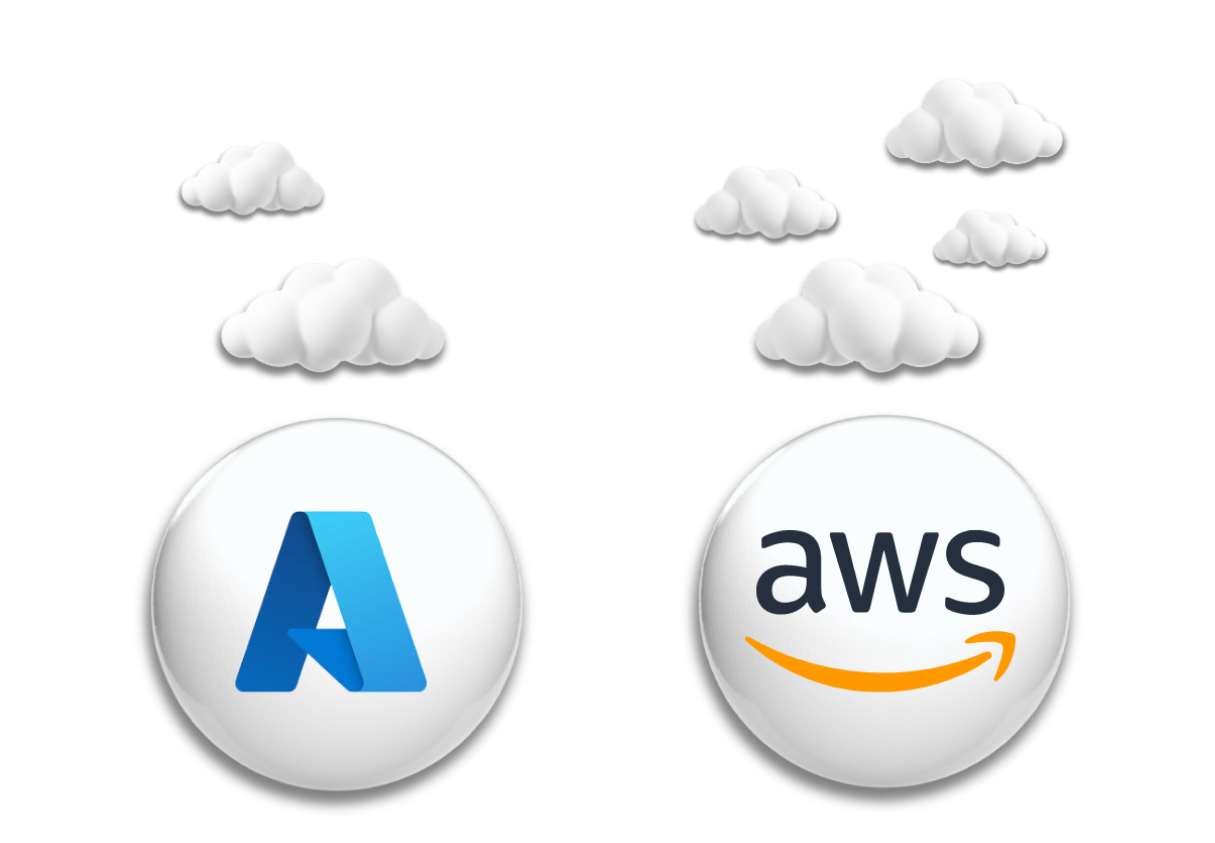The gaming industry is undergoing a significant transformation driven by the rapid adoption of cloud computing. Imagine playing the latest action-packed or strategy-heavy games without needing high-end PCs or the latest consoles. That’s not just possible now; it’s happening.
Cloud gaming, or gaming-as-a-service (GaaS), is changing how we access and enjoy games. The long waits for downloads and the need for specific devices are becoming things of the past. Now, whether you’re on your phone at a coffee shop or tablet at home, you can jump right into your games as long as you have an internet connection. This change is backed by improvements in distributed cloud technology and the rollout of 5G networks, which have cut down on the latency and connectivity issues that used to affect cloud gaming.
This shift is also marked by significant growth in the industry. The global cloud gaming industry is projected to grow significantly, reaching an estimated revenue of US$ 20,938.3 million by 2030. It is anticipated to expand at a compound annual growth rate (CAGR) of 45.5% from 2024 to 2030. Big names like Sony, Nintendo are making rapid advances, and Google’s launch of Stadia in 2019, which lets you play games on any screen, highlights this trend.
Looking ahead, the future of cloud gaming is promising, with more accessibility, flexibility, and a growing library of games that are as easy to access as streaming your favorite show. Let’s explore how cloud computing in the gaming industry is making the gaming experience more inclusive and exciting for players across the globe.
Understanding Cloud Computing in the Gaming Industry
Cloud computing transforms the gaming industry by enabling players to play games directly from remote servers. Users can enjoy gaming without downloading and installing games on their computer or console. Instead, games are streamed to the user’s device, like streaming videos on platforms like YouTube or Netflix.
Users can enjoy high-end games without powerful hardware on their laptops, smartphones, tablets, or smart TVs. Here is how it works:
- Game Streaming: Games are hosted on remote servers instead of the user’s local device.
- Data Centers: Powerful data centers store and process the game data, ensuring high-performance computing.
- Internet Connectivity: A high-speed and stable internet connection transmits game data between the server and the player’s device.
- Real-Time Interaction: Player inputs are sent to the server and processed in real-time, and the corresponding game outputs are streamed back to the player’s device.
- Device Independence: Players can access games on any device capable of streaming video, such as smartphones, tablets, or computers, without needing high-spec hardware.
- Subscription Model: Users typically access games through a subscription model, paying a regular fee to access a library of games.
- Scalability: Cloud infrastructure scales to accommodate many players simultaneously, ensuring consistent game performance regardless of player count.
Cloud computing allows users to access a vast library of games without worrying about hardware limitations. They can log in, select a game, and start playing right away.
Challenges in Cloud Gaming
While cloud gaming presents significant opportunities for growth and accessibility, it also faces several technical and infrastructural challenges that can impact user experience and operational efficiency. Here’s a breakdown of these challenges and potential solutions:
Reduced Visibility and Control
Cloud computing means less hands-on control over servers and systems, which can be a hurdle for businesses needing transparency in operations. Working with cloud providers that offer comprehensive insights into system performance and user activities can mitigate this issue.
Latency Issues
Latency is critical in gaming, where quick response times are crucial. High latency can disrupt the gaming experience and tarnish a company’s reputation. To combat this, gaming companies can set up servers in multiple regions or continents to minimize delay and enhance game responsiveness and streaming quality.
Security Vulnerabilities
Using APIs in cloud services offers flexibility and integration but can also introduce security risks. To protect data and prevent unauthorized access, it is vital to ensure that APIs are secure, possibly by implementing SSL encryption and multi-factor authentication.
Server Optimization
Servers must meet specific hardware requirements to provide smooth gameplay. The minimum network speed for standard play is 10 Mbps and 35 Mbps for 4K resolution. Optimizing server hardware and configuration, such as implementing GPU as a Service (GPUaaS), can help manage the load and improve performance.
Incompatibility with Legacy Systems
Shifting from on-premise solutions to cloud-based platforms can lead to compatibility issues. It’s important to evaluate which applications and data should be moved to the cloud and ensure the cloud services align with your existing technology stack.
Downtime and Connectivity
Dependence on internet connectivity means poor network performance can lead to downtime, affecting productivity and user experience. Ensuring high-speed internet access is essential for businesses to use cloud solutions effectively.
By addressing these challenges, companies can enhance their cloud gaming services and provide users worldwide with an exceptional and uninterrupted gaming experience.
The Impact of Cloud Computing on the Gaming Industry
Cloud computing facilitates seamless gameplay on various devices, reduces gamers’ barriers to entry, and streamlines content delivery. Below, we explore the benefits of cloud computing in gaming, highlighting how it enhances both the gamer’s experience and the developer’s production capabilities.
Enhanced Accessibility and Reach
Cloud gaming services eliminate the need for powerful hardware, allowing games to be streamed directly from servers. This opens up high-end gaming to a broader audience, regardless of their hardware capabilities. Whether players are using old laptops or modern smartphones, they have access to a library of games without the cost of hardware upgrades.
The global gaming market is expected to grow, and cloud gaming is a key driver. According to a report by Grand View Research, the global cloud gaming market size is expected to reach USD 7.24 billion by 2027, expanding at a compound annual growth rate (CAGR) of 45.5% from 2023 to 2030.
Flexibility and Convenience
Gamers can begin playing on one device and switch to another without losing progress. This cross-platform functionality means that games are no longer tied to specific consoles or PCs, making gaming more accessible on the go.
This feature particularly benefits mobile gamers who can enjoy desktop-quality games on their phones without extensive storage space, eliminating lengthy downloads and installations.
Scalability and Cost Efficiency for Developers
Game developers can scale their operations up or down without significant upfront investment in physical hardware. Cloud servers can handle heavy tasks such as graphics rendering and complex computations, allowing developers to adjust resources based on demand.
Cloud computing’s scalability helps manage costs and supports the development of more ambitious projects without the risk of resource underutilization.
Enhanced Multiplayer and Social Interactions
Cloud servers facilitate low-latency, real-time interactions for multiplayer games, connecting players across different geographical locations with minimal delay. This capability is crucial for competitive and cooperative online gaming, providing all participants with a smooth, synchronized gaming experience.
Cloud infrastructure supports enhanced social interactions and can handle the vast amounts of data transferred during multiplayer sessions, ensuring stable and continuous gameplay.
Improved Security and Reduced Piracy
Cloud gaming platforms enhance security by hosting games on secure servers, which manage all data transactions and storage. This helps mitigate risks such as piracy and cheating by controlling the game’s execution environment.
Updates and patches are applied directly to the servers, ensuring all players have the latest and most secure game version without manual updates, thus maintaining game integrity and security.
Efficient Game Updates and Content Delivery
Cloud platforms streamline the distribution of game updates and new content. Developers can deploy updates on the server side, which are instantly available to all players, eliminating the downtime associated with patch downloads.
This model enhances the user experience by swiftly providing the latest content and reducing the bandwidth costs of distributing large files to numerous users.
These advancements promote a more inclusive, secure, and innovative gaming environment, promising continued growth and diversification of the gaming industry.
What to Consider When Your Gaming Company Explores Cloud Gaming
Here are essential points that gaming companies should consider to navigate this emerging space successfully:
Utilizing Data Analytics for Game Selection
To build a gaming library that resonates with your audience, your business should utilize analytics to understand player preferences and market trends. Concentrate on titles and franchises known for their engagement and potential to attract a loyal fanbase to your cloud platform.
Optimizing Distribution Strategies
Options range from partnering with existing cloud streaming platforms, using combined cloud and Content Delivery Network (CDN) services, to developing your own networks. Collaborating with telecommunications companies can provide diverse and flexible gaming options to meet various player needs.
Capitalizing on Content to Drive Transition
Content is critical in attracting gamers. Your business can use successful gaming franchises and intellectual properties to drive users towards cloud gaming. Industry trends indicate that significant acquisitions often target content that can draw players to new platforms.
Integrating Emerging Technologies
To enhance the appeal of your cloud gaming offerings, incorporate cutting-edge technologies such as Artificial Intelligence (AI) and analytics. These can create more personalized and engaging gaming experiences. Furthermore, your business can explore integrating Augmented Reality (AR) and Virtual Reality (VR) into your cloud gaming services to offer immersive gameplay experiences previously limited by hardware constraints.
By carefully considering these aspects, gaming companies can better position themselves in the competitive landscape of cloud gaming, ensuring they meet and exceed player expectations and foster long-term engagement.
Recent Technological Advancements in Cloud Gaming
Here’s a look at the recent technological advancements in this dynamic field:
5G Technology
The rollout of 5G networks has significantly impacted cloud gaming by reducing latency and increasing bandwidth availability. This technology allows for faster data transmission, reducing lag, which is crucial for a seamless gaming experience, especially in fast-paced games.
Advanced Compression Algorithms
New compression techniques have been developed to decrease the data needed to stream high-quality video and audio. This reduces the bandwidth needed and lessens the delay between player input and on-screen action, which is crucial for maintaining gameplay responsiveness.
AI and Machine Learning
AI and machine learning are integrated into cloud gaming to improve user interactions and personalize the gaming experience. AI can optimize resource allocation based on demand prediction and player behavior, ensuring that server resources are efficiently used without compromising game performance.
Edge Computing
By processing data closer to the user, edge computing reduces the distance data needs to travel, decreasing latency. This is particularly beneficial for cloud gaming, where reducing latency is crucial for maintaining the game’s responsiveness.
Cross-Platform Gaming
Gamers can now play the same game across different devices, including consoles, PCs, and mobile devices, without any loss in progress or performance.
Virtual Reality (VR) Integration
The cloud handles the heavy computing load, allowing users with less powerful hardware to enjoy VR/AR games, which typically require significant processing power and graphical capabilities.
These advancements are driving the rapid growth of cloud gaming, transforming it into a more accessible, efficient, and immersive form of entertainment.
Drive Your Cloud Success with Avahi’s Cloud Solutions
Avahi specializes in delivering innovative cloud solutions that address your unique business challenges. As your dedicated AWS Cloud Consulting Partner, we are committed to simplifying your cloud journey through seamless adoption, migration, and application modernization.
Our Services Include:
- Adoption and Migration: Migrate your legacy applications or workloads to AWS for enhanced reliability, scalability, and performance.
- DevOps: Unlock the power of your data with advanced analytics and machine learning capabilities.
- Cloud Staffing Services: Access top-tier talent to support and drive your initiatives, ensuring a seamless and effective cloud transformation.
Want to explore how Avahi can help you simplify, modernize, and excel in your cloud journey?

